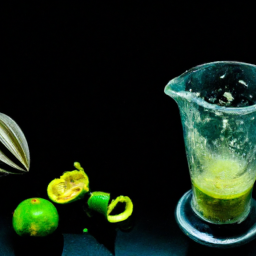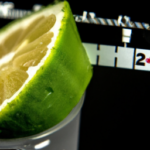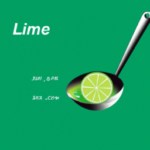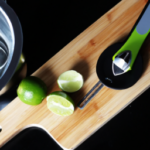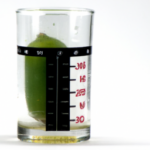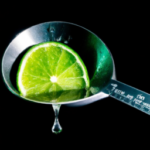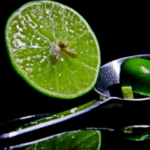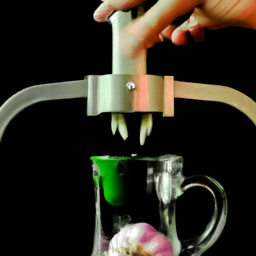As a professional chef and someone who loves cooking at home, I have come to appreciate the important role that lime juice plays in a wide range of recipes. Whether it’s used in marinades or cocktails, the tangy and citrusy flavor of lime juice can elevate the taste of almost any dish.
However, one question that often arises is how much lime juice can you expect from a single lime? The amount of juice in a lime can vary based on a few factors, such as the size of the lime, its ripeness, and the method used to extract the juice.
As someone who has squeezed countless limes over the years, I’ve learned a few tips and tricks for maximizing the amount of juice I can get from each lime. In this article, I’ll share my knowledge and experience to help you estimate how much lime juice you can expect from a single lime, as well as provide some tips for maximizing juice extraction and storing your lime juice for future use.
Key Takeaways
- Lime juice yield per fruit varies depending on the type of lime, with Persian limes producing around 2 tablespoons, Key limes producing 1-2 tablespoons, and Bearss limes producing up to 1/4 cup.
- The amount of lime juice needed in a recipe can vary based on recipe-specific requirements and personal taste preferences.
- Lime juice is an essential ingredient in many recipes, including margaritas, key lime pie, marinades, salad dressings, and salsa.
- To maximize lime juice extraction, it is helpful to choose a ripe lime, warm it up before juicing, roll it to loosen juice pockets, and use a citrus juicer or hand-held citrus reamer. Experimentation can also be key to adjusting the acidity and flavor of lime juice in a recipe.
Factors Affecting the Amount of Juice in a Lime
You’ll want to make sure you’re choosing a ripe lime if you want to get the maximum amount of juice out of it. A ripe lime will be slightly soft to the touch and give off a fragrant citrus scent. If you’re unsure, give it a gentle squeeze – a ripe lime will yield slightly.
In addition to choosing a ripe lime, having the right juicing tools can make a big difference in how much juice you can extract. A citrus juicer or a hand-held citrus reamer are both good options. These tools are designed to extract as much juice as possible while leaving behind the bitter pith.
By using a good juicing tool and a ripe lime, you’ll be able to get the most out of your citrus. Now, let’s move on to estimating the amount of lime juice.
Estimating the Amount of Lime Juice
When it comes to adding a tangy twist to your recipes, squeezing out the liquid gold from a certain green citrus fruit can do wonders. But how do you estimate the amount of lime juice you can extract from one lime? The answer isn’t as straightforward as you might think, as it can vary depending on various factors such as the type of lime and its ripeness.
However, here are some general estimates to keep in mind:
- Persian limes, which are the most common type found in grocery stores, typically yield around 2 tablespoons of juice per fruit.
- Key limes, which are smaller and more acidic than their Persian counterparts, yield around 1-2 tablespoons of juice per fruit.
- Bearss limes, which are larger and less acidic than Persian limes, can yield up to 1/4 cup of juice per fruit.
To maximize your juice extraction, it’s important to choose the right type of lime for your recipe and ensure it’s at its peak ripeness. In the next section, we’ll explore some tips for getting the most juice out of your limes.
Tips for Maximizing Juice Extraction
When it comes to extracting the maximum amount of juice from a lime, I’ve got a few tricks up my sleeve.
First, I always warm up the lime by rolling it back and forth on a hard surface with the palm of my hand. This helps to loosen up the juice inside.
Next, I cut the lime in half crosswise instead of lengthwise and use a citrus juicer to squeeze every last drop out.
By following these simple tips, you can get the most juice out of your limes and ensure that your dishes are bursting with flavor.
Warming the Lime
To extract more juice from a lime, it’s helpful to warm it up before squeezing. There are many heating techniques you can use, such as putting the lime in the microwave for a few seconds or rolling it on a countertop.
Heating the lime will help to soften the membranes inside the fruit, making it easier to extract the juice. Not only will warming the lime make it easier to squeeze, but it can also improve the flavor impact.
When a lime is at room temperature, the essential oils that give it its distinct flavor are more readily released. So, by warming up the lime beforehand, you can enhance the flavor of your lime juice.
Now that we’ve covered warming the lime, let’s move on to the next step of maximizing juice extraction: rolling the lime.
Rolling the Lime
Now that we’ve warmed up our lime, let’s move on to the next step: rolling it.
Rolling a lime before juicing it has many benefits. Here are some juicing techniques that I’ve learned over the years that make rolling the lime a crucial step in the process:
- Rolling the lime helps to loosen the juice pockets inside the fruit, making it easier to extract all the juice.
- Rolling also helps to break down the cell walls of the lime, releasing more juice and making the juice smoother and less bitter.
- By rolling the lime, you can get up to 20% more juice from it than if you were to simply cut it in half and squeeze it.
By incorporating these juicing techniques, you’re getting the most out of your lime and ensuring that you have enough juice for your recipe.
Now that we’ve rolled our lime, it’s time to move on to the next step: cutting it.
Cutting the Lime
Let’s dive into the next step of the process: cutting our zesty citrus fruit. When it comes to cutting limes, there are various techniques that can be used depending on the desired outcome. The most common method is to cut the lime in half and extract the juice using a juicing tool such as a reamer or citrus press. However, if you want to use the lime for garnish or zest, you may want to consider other cutting techniques such as slicing or wedging.
To help you visualize the different cutting techniques, here is a table outlining the steps for each method:
| Cutting Technique | Steps |
|---|---|
| Half | Cut the lime in half lengthwise |
| Slicing | Cut the lime into thin rounds |
| Wedging | Cut the lime into wedges by cutting it in half, then in half again, and so on |
Now that we have our lime cut, it’s time to move onto the next step: determining how much lime juice we will need for our recipe.
How Much Lime Juice Do You Need?
When it comes to lime juice, it’s important to know how much you need for your recipe. This can vary depending on the recipe-specific requirements and your personal taste preferences.
As someone who frequently uses lime juice in my cooking, I’ve learned the importance of adjusting the amount of juice based on these factors to ensure the perfect balance of flavors in my dishes.
Recipe-Specific Requirements
To make sure the recipe turns out just right, it’s important to know that one lime typically yields about 2 tablespoons of lime juice, so don’t forget to measure it out! Measurement accuracy is crucial when it comes to lime juice, as too much or too little can completely change the taste of your recipe. If you don’t have fresh limes on hand, lime juice substitutes such as bottled lime juice or even lemon juice can be used, but keep in mind that the taste may be slightly different.
When it comes to recipe-specific requirements, some recipes may call for more or less lime juice depending on the other ingredients. Here are some examples of recipe-specific lime juice requirements to keep in mind:
-
Margaritas typically require 1.5 ounces (or 3 tablespoons) of lime juice per serving
-
Key lime pie requires about 1/2 cup of lime juice for a standard 9-inch pie
-
Marinades for meat or fish may call for a larger amount of lime juice to help tenderize the protein
-
Salad dressings may only require a small amount of lime juice for a subtle citrus flavor
-
Salsa recipes may vary in the amount of lime juice needed depending on the desired level of acidity.
Remember, adjusting for personal taste is always an option. If you prefer a stronger lime flavor, you can add more juice accordingly.
Adjusting for Personal Taste
Adjusting for personal taste is always an option when it comes to lime juice. While some recipes may call for a specific amount, it’s important to remember that everyone’s taste buds are different. Some people may prefer a more acidic taste, while others may want a slightly sweeter flavor. Experimentation is key when it comes to adjusting the acidity and flavor of lime juice in a recipe.
To adjust the acidity of lime juice, start by adding small amounts at a time and taste-testing as you go. If you find the lime juice too tart, try adding a pinch of sugar or honey to balance out the flavors. On the other hand, if you prefer a more tangy taste, try adding a little extra lime juice. Don’t be afraid to get creative and experiment with different flavors to find the perfect balance for your personal taste.
Moving on to other uses for lime juice, it’s important to note that it’s not just a great addition to recipes. Lime juice can also be used as a natural cleaner, to freshen up your garbage disposal, and even as a natural deodorant.
So, the next time you have some extra lime juice on hand, try using it for something other than cooking or baking.
Other Uses for Lime Juice
I love using lime juice not just for cooking, but also for cleaning and deodorizing my home. It’s a natural and effective way to get rid of unpleasant odors in the kitchen, bathroom, and even my shoes!
Plus, lime juice has many health and beauty benefits that I take advantage of. It’s a great source of vitamin C and antioxidants, and can be used to brighten skin and hair.
Cleaning and Deodorizing
When life gives you limes, don’t just stop at using the juice for cooking and cocktails! Limes are a natural cleaning agent and their acidic properties make them great for deodorizing.
Cleaning lime is perfect for removing tough stains, grease, and grime. Mix equal parts lime juice and water to create a cleaning solution that can be used on surfaces like countertops, sinks, and even floors. The lime juice cuts through dirt and grime while the water dilutes it enough to make it safe for use on most surfaces.
The deodorizing properties of lime juice make it a great addition to any cleaning routine. Its fresh and citrusy scent can help mask unpleasant odors, making it perfect for use in the bathroom or kitchen. Simply mix lime juice with water and use it as a natural air freshener by spraying it around the room.
With cleaning and deodorizing properties like these, it’s no wonder why lime juice is a must-have in any household. Now, let’s move on to how it can benefit our health and beauty routines.
Health and Beauty
After cleaning and deodorizing, it’s time to talk about the health and beauty benefits of lime. As a personal assistant, I’ve seen how lime can be used in various ways to enhance one’s physical appearance.
The amount of lime juice in one lime may vary, but its benefits for the skin and hair growth are undeniable. When it comes to skincare, lime is an excellent source of vitamin C, which helps brighten the skin and reduce the appearance of dark spots. It also has natural astringent properties that can help tighten pores and reduce oil production. Moreover, lime juice can be used as a natural exfoliant, helping to remove dead skin cells and revealing brighter, smoother skin.
On the other hand, lime juice is also a great source of nutrients that can promote hair growth. Its acidic properties can help balance the pH levels of the scalp, which can lead to healthier and stronger hair growth. It can also help unclog hair follicles, promoting better blood circulation and nutrient absorption.
Here are some ways to use lime for the skin:
- Mix lime juice with honey and apply as a face mask for brighter, smoother skin.
- Use lime juice as a toner by mixing it with water and dabbing it on the face with a cotton ball.
- Add lime juice to a warm bath to help detoxify the skin and reduce body odor.
Here are some ways to use lime for hair growth:
- Mix lime juice with coconut oil and massage onto the scalp for better blood circulation and hair growth.
- Use lime juice as a hair rinse after shampooing to balance the pH levels of the scalp and promote healthy hair growth.
- Mix lime juice with henna powder to create a natural hair dye that can help strengthen and nourish the hair.
As we’ve seen, lime juice can offer numerous benefits for both the skin and hair. However, it’s also essential to note that lime juice isn’t the only citrus juice with these properties. In the next section, we’ll compare lime juice to other citrus juices to see which one is best for your health and beauty needs.
Comparing Lime Juice to Other Citrus Juices
Citrus juices like lemon and grapefruit have a more distinct flavor than lime juice. While lime juice is tangy and refreshing, it’s milder in taste compared to other citrus juices. However, this doesn’t mean that lime juice is any less beneficial or nutritious. In fact, lime juice is a great source of vitamin C and antioxidants, which are important for maintaining a healthy immune system and fighting off free radicals in the body.
When it comes to comparing lime juice to other citrus juices, it’s important to note that each type of juice has its own unique set of benefits. For example, lemon juice is known for its detoxifying properties, while grapefruit juice is high in fiber and can aid in weight loss. However, if you’re looking for a versatile citrus juice that can be used in a variety of dishes and drinks, lime juice is a great choice. Its mild flavor allows it to blend well with other ingredients, making it a popular choice in cocktails, marinades, and dressings.
Speaking of using lime juice in dishes and drinks, it’s important to know how to properly store it to maintain its freshness and flavor.
Storing Lime Juice
To ensure your lime juice stays fresh and flavorful, make sure to store it in an airtight container in the fridge. This is because lime juice is highly sensitive to air and light, which can cause it to spoil quickly.
By keeping it in a sealed container, you can prevent oxidation and preserve its freshness for a longer period. When storing lime juice, it’s also important to keep it away from other strong-smelling foods, as it can absorb their flavors and aromas.
Additionally, make sure to label your container with the date you opened it to keep track of its shelf life. With proper storage techniques, you can enjoy the zesty flavor and health benefits of lime juice for weeks to come.
Frequently Asked Questions
What are the benefits of consuming lime juice?
As a health enthusiast, I can attest to the numerous benefits of consuming lime juice. From boosting immunity to aiding digestion, this versatile fruit is a must-have in any kitchen. Its culinary uses are endless, making it a staple ingredient in many dishes.
Can lime juice be used as a natural remedy for any ailments?
As someone who has used lime juice for skincare and cleaning, I can attest to its natural healing properties. Its high vitamin C content helps brighten and tighten skin, while its acidity makes it a powerful cleaning agent.
How long does it take for a lime to ripen and produce the most juice?
As someone who has grown limes for years, I know that the ripening time can vary depending on the climate. However, waiting until the lime is fully yellow and slightly soft will produce the most juice. Juicing techniques will also affect the amount of juice extracted.
What is the nutritional value of lime juice?
As an experienced chef, I know that lime juice has numerous health benefits. It’s rich in vitamin C and antioxidants, which can boost the immune system and fight inflammation. Lime juice is a versatile ingredient in many recipes, adding a tangy and refreshing flavor to dishes.
Is it possible to extract lime juice without a juicer or citrus press?
As a seasoned cook, I can attest that hand-squeezing lime juice is possible without a juicer or citrus press. While machine-extracted juice may offer convenience, its shelf life pales in comparison to the freshness of hand-squeezed juice.
Conclusion
In my experience, the amount of juice in a lime can vary depending on several factors, such as the ripeness of the fruit, its size, and even the time of year it was harvested. However, with some practice and a few helpful tips, it’s easy to get the most out of your limes and ensure that you have enough juice for your recipes.
One helpful tip I’ve found is to roll the lime on a hard surface before cutting it – this helps to break down the pulp and release more juice. Additionally, using a citrus juicer or reaming tool can make the process even easier.
Overall, I’ve found that a single lime can typically yield around 2 tablespoons of juice, but this can vary based on the factors mentioned above.
Using lime juice in your cooking and cocktails can add a bright, refreshing flavor that is unmatched by other citrus fruits. Its tangy, zesty taste can make any dish feel like a tropical getaway, and its vibrant green color is sure to brighten up any recipe.
With these tips in mind, you can confidently incorporate lime juice into your cooking and enjoy its unique flavor and versatility. So go ahead – squeeze away and let the sunshine in!
Ilana has been a vegan for over 10 years. She originally made the switch for health reasons, but soon found herself becoming more and more passionate about the ethical and environmental implications of a vegan lifestyle. Ilana is the author of The Graceful Kitchen, a blog all about veganism. She loves to cook up delicious and nutritious vegan meals, and share her recipes with others who are interested in leading a cruelty-free life. Ilana is also a strong advocate for using whole foods as the foundation of a healthy diet, and believes that going vegan is one of the best ways to achieve this.

